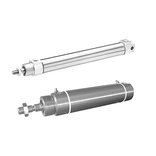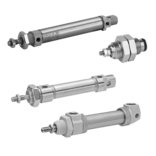What are the precautions for using the rotary clamping cylinder
What are the precautions for using the rotary clamping cylinder
Rotary clamping cylinder refers to the cylinder that can expand and contract when the piston rod rotates 90° (or right), and then the workpiece is clamped by the clamping arm through the clamping stroke, which is used to clamp small workpieces. Compared with direct clamping, the space above the workpiece can be effectively used before clamping. There are two types of rotary clamping cylinders: standard and heavy. The heavy-duty type can withstand greater moments of inertia.

Precautions for use:
1. Do not use in the following environments: cutting oil and other liquids acting on the piston rod; dusty places, welding sparks and chips; ambient temperature exceeding the allowable value; places with corrosive fluids; places exposed to direct sunlight.
2. When assembling and disassembling the clamp arm, use a wrench to fix the clamp arm and tighten or loosen the screws.
3.After the clamping arm is qualified, calculate the moment of inertia of the rotating parts such as the clamping arm, and require the allowable bending moment and moment of inertia of the Wuxi cylinder to be within the scope of use. If the clamping arm is too long and the load mass is too large, the internal parts of the cylinder will be damaged.

4. The cylinder is installed vertically; no external force is allowed in the direction of rotation; clamping is not allowed within the range of rotation stroke, and can only be clamped within the range of tightening stroke. The clamping surface is perpendicular to the axis of the cylinder, that is, it is not allowed to clamp the inclined surface. During the tightening process, the piston rod of the Wuxi cylinder is not allowed to bear rotating torque (such as the clamped workpiece is still in motion)
5. The clamping arm moves up and down when rotating, so be careful not to clamp the handle within its range of motion.





